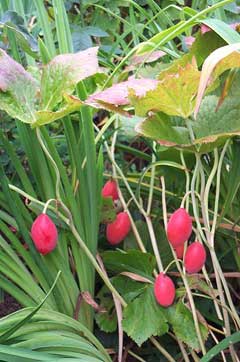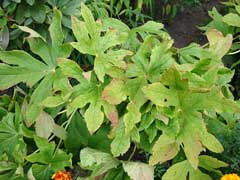 |
|
http://commons.wikimedia.org/wiki/User:Andy_king50 |
 |
|
Translate this page:
Summary
Physical Characteristics

 podophyllum hexandrum is a PERENNIAL growing to 0.5 m (1ft 8in) by 0.3 m (1ft).
podophyllum hexandrum is a PERENNIAL growing to 0.5 m (1ft 8in) by 0.3 m (1ft).
See above for USDA hardiness. It is hardy to UK zone 6 and is not frost tender. It is in flower from May to June, and the seeds ripen from July to August. The species is hermaphrodite (has both male and female organs). The plant is not self-fertile.
Suitable for: light (sandy) and medium (loamy) soils and prefers well-drained soil. Suitable pH: mildly acid, neutral and basic (mildly alkaline) soils. It can grow in full shade (deep woodland) or semi-shade (light woodland). It prefers moist soil.
UK Hardiness Map
US Hardiness Map
Synonyms
P. emodi.
Plant Habitats
Woodland Garden Dappled Shade; Shady Edge; not Deep Shade;
Edible Uses
Edible Parts: Fruit
Edible Uses:
Fruit - raw. It must only be eaten when it is fully ripe[1, 2, 61, 105]. Juicy but insipid[130]. The fruit is about 5cm long[200]. The leaves are edible according to one report but this must be treated with some caution, see notes on toxicity above[183].
References More on Edible Uses
Medicinal Uses
Plants For A Future can not take any responsibility for any adverse effects from the use of plants. Always seek advice from a professional before using a plant medicinally.
Antirheumatic Cancer Cholagogue Cytostatic Purgative
The whole plant, but especially the root, is cholagogue, cytostatic and purgative. The plant contains podophyllin, which has an antimiotic effect (it interferes with cell division and can thus prevent the growth of cells). It is, therefore, a possible treatment for cancer, and has been used especially in the treatment of ovarian cancer[46, 51, 57, 64, 65, 124, 244]. However, alopecia is said to be a common side-effect of this treatment[244]. This species contains about twice the quantity of active ingredient than P. peltatum[211]. The roots contain several important anti-cancer lignans, including podophyllin and berberine[218]. The roots are also antirheumatic[218]. The root is harvested in the autumn and either dried for later use or the resin is extracted[238]. This plant is highly poisonous and should only be used under the supervision of a qualified practitioner[238]. It should not be prescribed for pregnant women[238].
References More on Medicinal Uses
The Bookshop: Edible Plant Books
Our Latest books on Perennial Plants For Food Forests and Permaculture Gardens in paperback or digital formats.

Edible Tropical Plants
Food Forest Plants for Hotter Conditions: 250+ Plants For Tropical Food Forests & Permaculture Gardens.
More

Edible Temperate Plants
Plants for Your Food Forest: 500 Plants for Temperate Food Forests & Permaculture Gardens.
More

More Books
PFAF have eight books available in paperback and digital formats. Browse the shop for more information.
Shop Now
Other Uses
A medicinal resin is obtained from the plant. It is extracted with alcohol[64].
Special Uses
References More on Other Uses
Cultivation details
Prefers a moist peaty soil and filtered light or shade[111, 187]. Grows well in a moist open woodland[28, 31, 200]. Hardy to about -20°c[187], it takes some years to become established[124] but is very long lived in a suitable habitat[130]. Young leaves may be damaged by late frosts but otherwise the plants are quite hardy[130]. Over collection of the plant from the wild is becomimg a cause for concern as local populations are being endangered[272]. Young plants only produce one leaf each year, older plants have 2 or 3 leaves each year[211]. Plants in this genus have excited quite a lot of interest for the compounds found in their roots which have been shown to have anti-cancer activity[124]. There are various research projects under way (as of 1990)[124]. The sub-species P. hexandrum chinense. Wall. has larger flowers and more deeply divided leaves[187].
References Carbon Farming Information and Carbon Sequestration Information
Temperature Converter
Type a value in the Celsius field to convert the value to Fahrenheit:
Fahrenheit:
The PFAF Bookshop
Plants For A Future have a number of books available in paperback and digital form. Book titles include Edible Plants, Edible Perennials, Edible Trees,Edible Shrubs, Woodland Gardening, and Temperate Food Forest Plants. Our new book is Food Forest Plants For Hotter Conditions (Tropical and Sub-Tropical).
Shop Now
Plant Propagation
Seed - best sown as soon as it is ripe in a cold frame. Sow stored seed in a cold frame in early spring. The seed germinates in 1 - 4 months at 15°c. Prick out the seedlings into individual pots when they are large enough to handle and grow on in a shady part of the greenhouse for at least 2 growing seasons. Plant them out into their permanent positions in the winter when the plants are dormant. Division in March/April[111].
Other Names
If available other names are mentioned here
Native Range
TEMPERATE ASIA: Afghanistan (northeast), China (Gansu Sheng, Qinghai Sheng, Shaanxi Sheng, Sichuan Sheng, Xizang Zizhiqu, Yunnan Sheng) TROPICAL ASIA: Bhutan, India (Sikkim, Himachal Pradesh, Jammu and Kashmir (north), Uttar Pradesh, Arunachal Pradesh), Nepal, Pakistan (north)
Weed Potential
Right plant wrong place. We are currently updating this section.
Please note that a plant may be invasive in one area but may not in your area so it's worth checking.
Conservation Status
IUCN Red List of Threatened Plants Status :

Growth: S = slow M = medium F = fast. Soil: L = light (sandy) M = medium H = heavy (clay). pH: A = acid N = neutral B = basic (alkaline). Shade: F = full shade S = semi-shade N = no shade. Moisture: D = dry M = Moist We = wet Wa = water.
Now available:
Food Forest Plants for Mediterranean Conditions
350+ Perennial Plants For Mediterranean and Drier Food Forests and Permaculture Gardens.
[Paperback and eBook]
This is the third in Plants For A Future's series of plant guides for food forests tailored to
specific climate zones. Following volumes on temperate and tropical ecosystems, this book focuses
on species suited to Mediterranean conditions—regions with hot, dry summers and cool, wet winters,
often facing the added challenge of climate change.
Read More
Expert comment
Author
Royle.
Botanical References
51200
Links / References
For a list of references used on this page please go here
Readers comment
© 2010, Plants For A Future. Plants For A Future is a charitable company limited by guarantee, registered in England and Wales. Charity No. 1057719, Company No. 3204567.